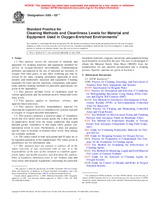Potrebujeme váš súhlas na využitie jednotlivých dát, aby sa vám okrem iného mohli ukazovať informácie týkajúce sa vašich záujmov. Súhlas udelíte kliknutím na tlačidlo „OK“.
ASTM G93-03e1
Standard Practice for Cleaning Methods and Cleanliness Levels for Material and Equipment Used in Oxygen-Enriched Environments (Includes all amendments And changes 12/31/2010).
Automaticky preložený názov:
Štandardná prax pre čistenie Metódy a úroveň čistoty pre materiál a zariadenia používané v obohatené kyslíkom prostredí
NORMA vydaná dňa 1.11.2003
Informácie o norme:
Označenie normy: ASTM G93-03e1
Poznámka: NEPLATNÁ
Dátum vydania normy: 1.11.2003
Kód tovaru: NS-57878
Počet strán: 22
Približná hmotnosť: 66 g (0.15 libier)
Krajina: Americká technická norma
Kategória: Technické normy ASTM
Anotácia textu normy ASTM G93-03e1 :
Keywords:
cleanliness, chemical, level, oxygen
Doplňujúce informácie
| Significance and Use | ||||||||||||||||||||||||||||||||||||||||
|
The purpose of this practice is to furnish qualified technical personnel with pertinent information for the selection of cleaning methods for cleaning materials and equipment to be used in oxygen-enriched environments. This practice furnishes qualified technical personnel with guidance in the specification of oxygen system cleanliness needs. It does not actually specify cleanliness levels. Insufficient cleanliness of components used in oxygen systems can result in the ignition of contaminants or components by a variety of mechanisms such as particle, mechanical, or pneumatic impact. These mechanisms are explained in detail in Guide G 88. Adequate contamination control in oxygen systems is imperative to minimize hazards and component failures that can result from contamination. Contamination must also be minimized to ensure an acceptable product purity. Removal of contaminants from materials and components depends on system configuration, materials of construction, and type and quantity of contaminant. Examples of cleaning procedures contained herein may be followed or specified for those materials, components, and equipment indicated. The general cleaning text can be used to establish cleaning procedures for materials, components, equipment, and applications not addressed in detail. See Guide G 127 for discussion of cleaning agent and procedure selection. |
||||||||||||||||||||||||||||||||||||||||
| 1. Scope | ||||||||||||||||||||||||||||||||||||||||
|
1.1 This practice covers the selection of methods and apparatus for cleaning materials and equipment intended for service in oxygen-enriched environments. Contamination problems encountered in the use of enriched air, mixtures of oxygen with other gases, or any other oxidizing gas may be solved by the same cleaning procedures applicable to most metallic and nonmetallic materials and equipment. Cleaning examples for some specific materials, components, and equipment, and the cleaning methods for particular applications, are given in the appendices. 1.2 This practice includes levels of cleanliness used for various applications and the methods used to obtain and verify these levels. 1.3 This practice applies to chemical-, solvent-, and aqueous-based processes. 1.4 This practice describes nonmandatory material for choosing the required levels of cleanliness for systems exposed to oxygen or oxygen-enriched atmospheres. 1.5 This practice proposes a practical range of cleanliness levels that will satisfy most system needs, but it does not deal in quantitative detail with the many conditions that might demand greater cleanliness or that might allow greater contamination levels to exist. Furthermore, it does not propose specific ways to measure or monitor these levels from among the available methods. 1.6 The values stated in both inch-pound and SI units are to be regarded separately as the standard unit. The values given in parentheses are for information only. This standard does not purport to address all of the safety concerns, if any, associated with its use. It is the responsibility of the user of this standard to establish appropriate safety and health practices and determine the applicability of regulatory limitations prior to use. Federal, state and local safety and disposal regulations concerning the particular hazardous materials, reagents, operations, and equipment being used should be reviewed by the user. The user is encouraged to obtain the Material Safety Data Sheet (MSDS) from the manufacturer for any material incorporated into a cleaning process. Specific cautions are given in Section . |
||||||||||||||||||||||||||||||||||||||||
| 2. Referenced Documents | ||||||||||||||||||||||||||||||||||||||||
|
Odporúčame:
Aktualizácia technických noriem
Chcete mať istotu, že používate len platné technické normy?
Ponúkame Vám riešenie, ktoré Vám zaistí mesačný prehľad o aktuálnosti noriem, ktoré používate.
Chcete vedieť viac informácií ? Pozrite sa na túto stránku.




 Cookies
Cookies
